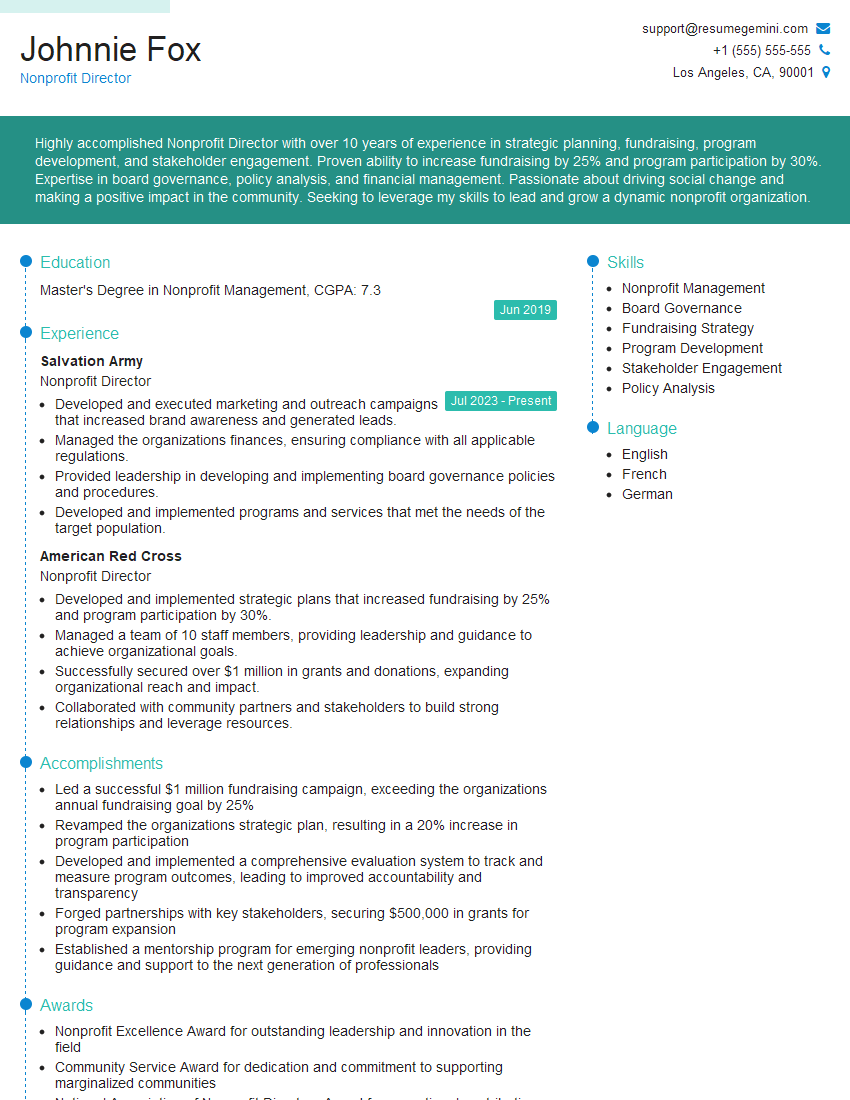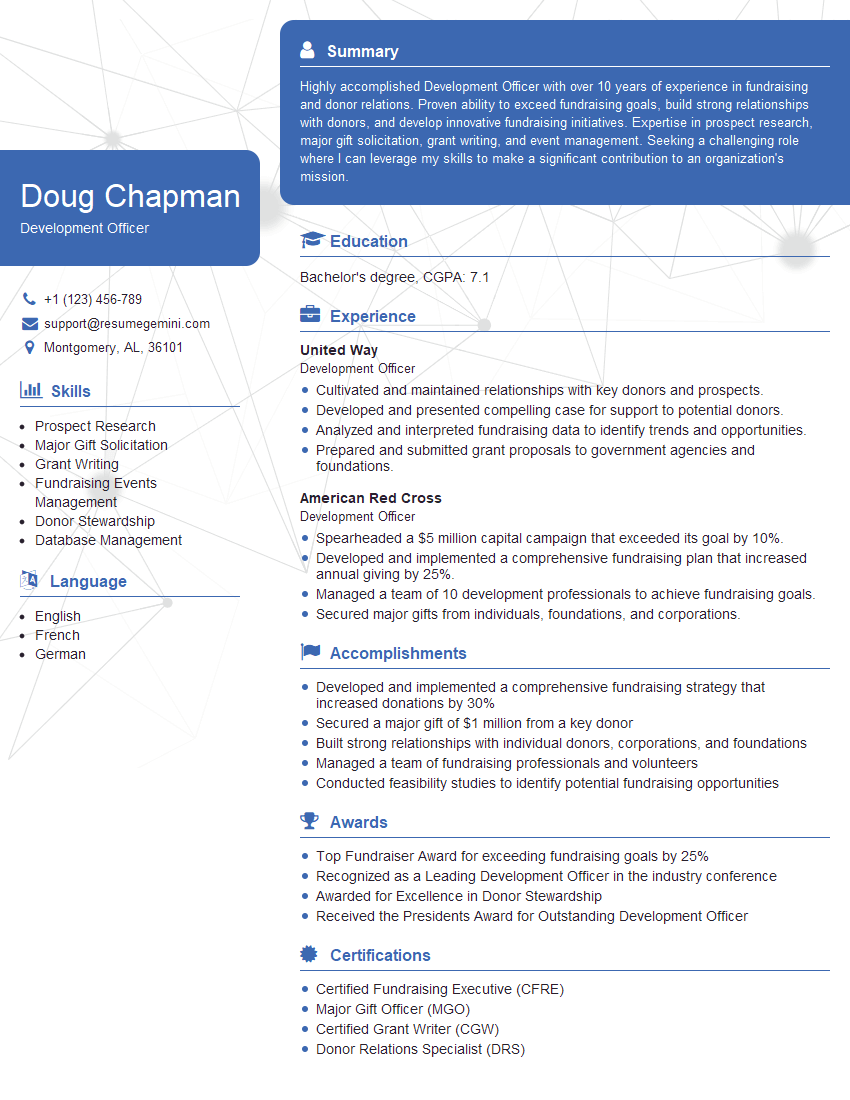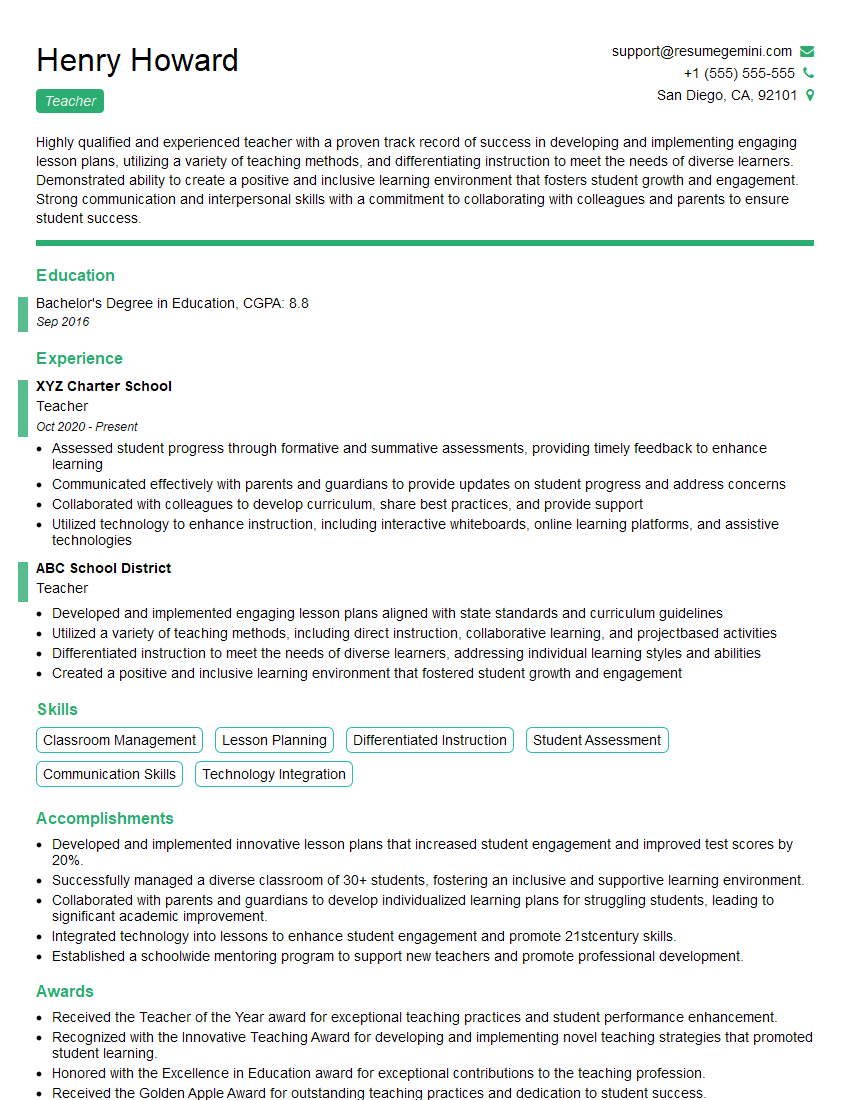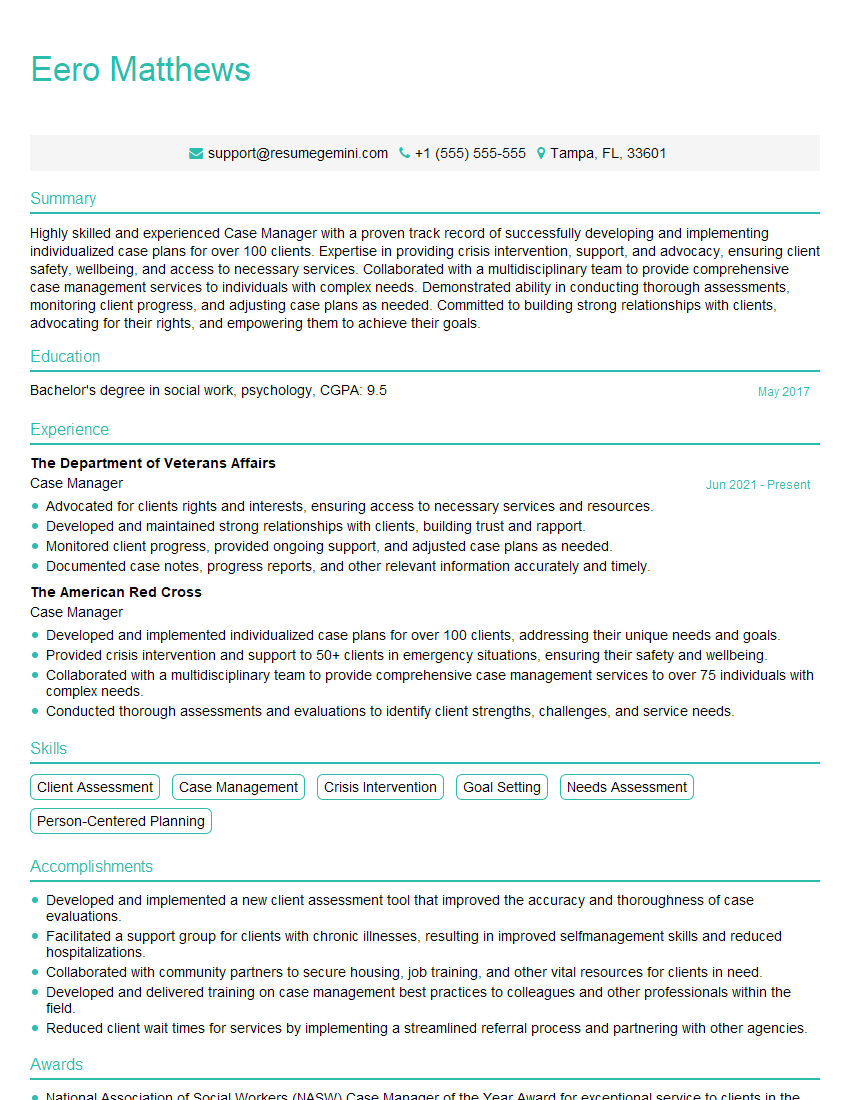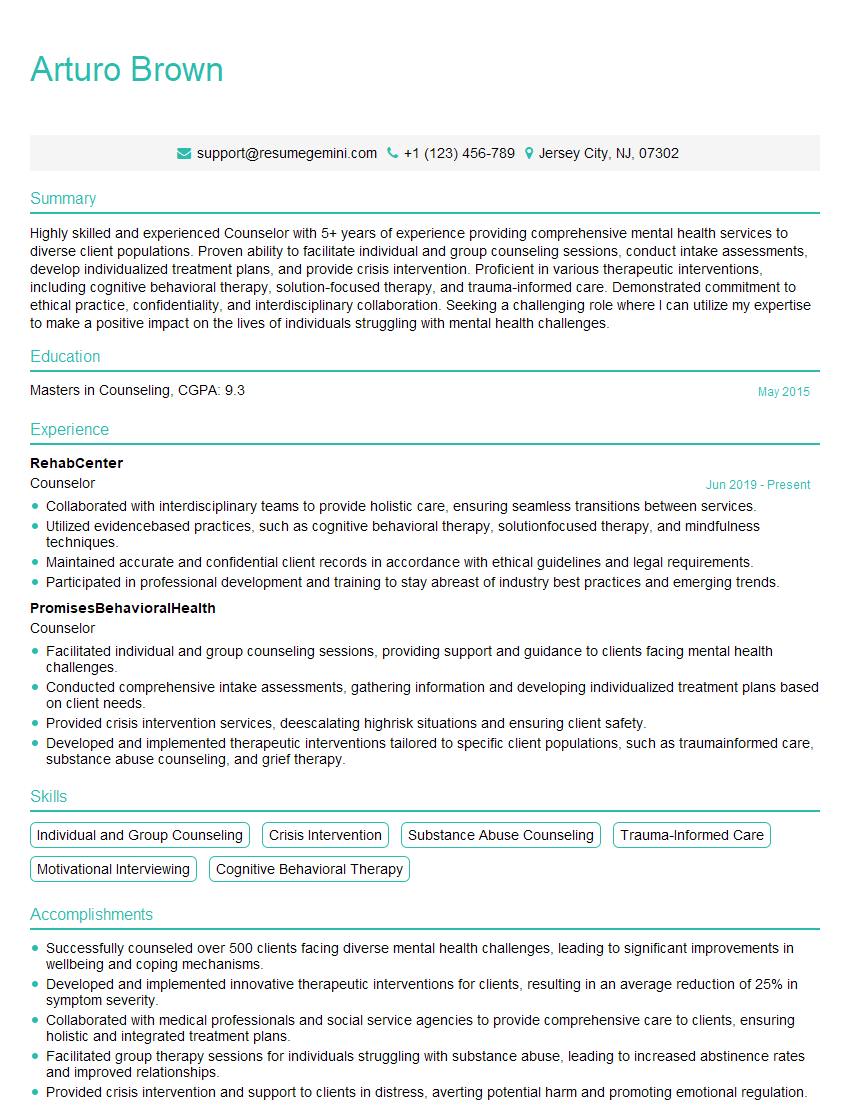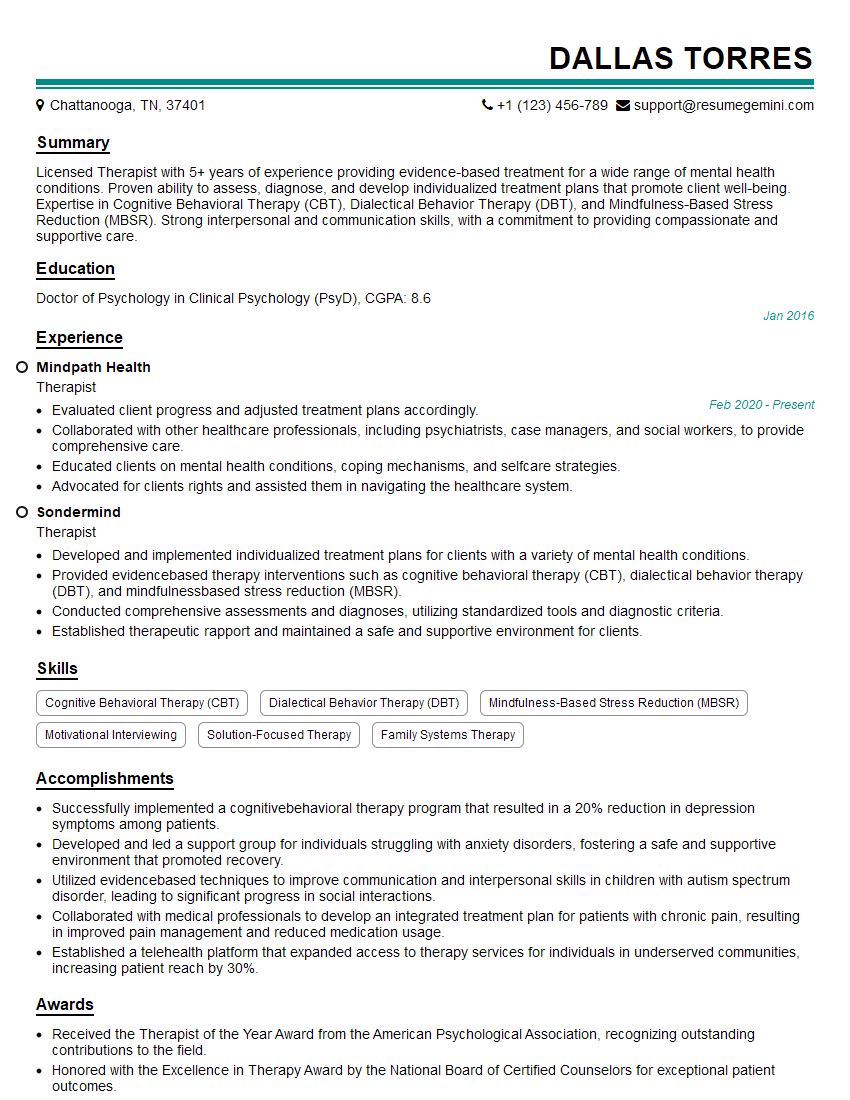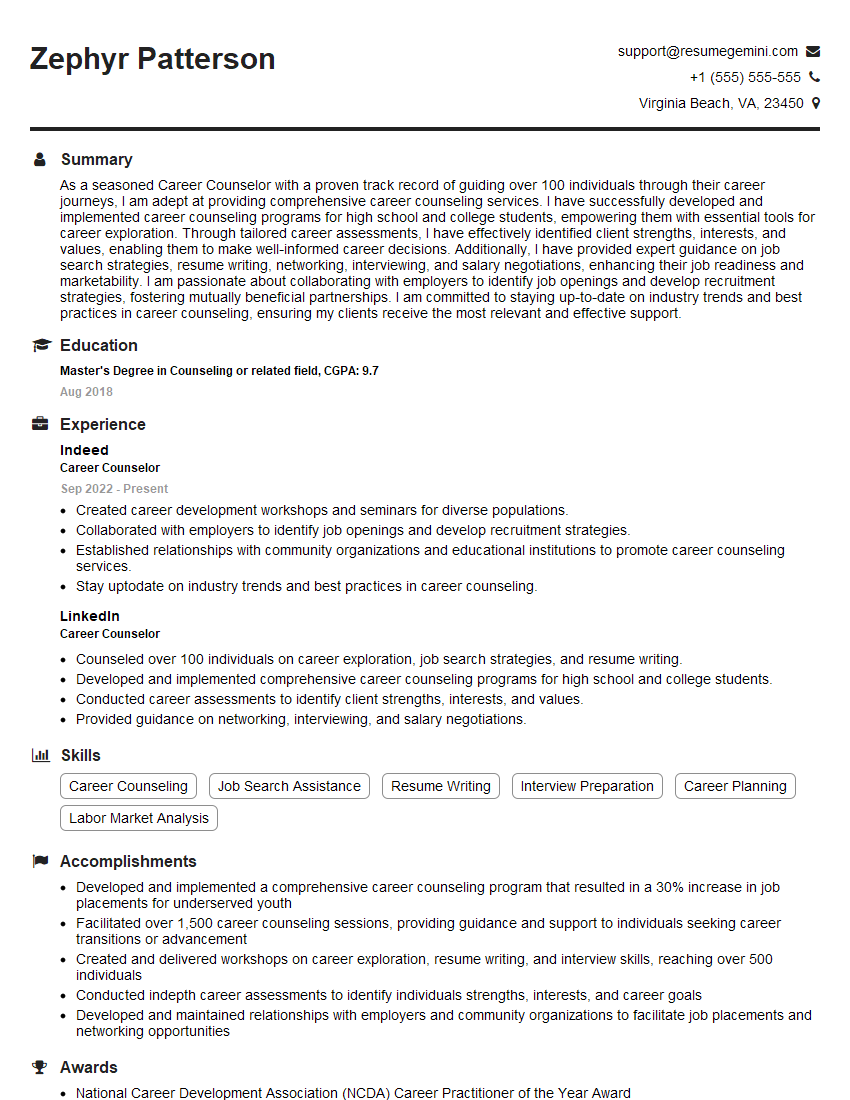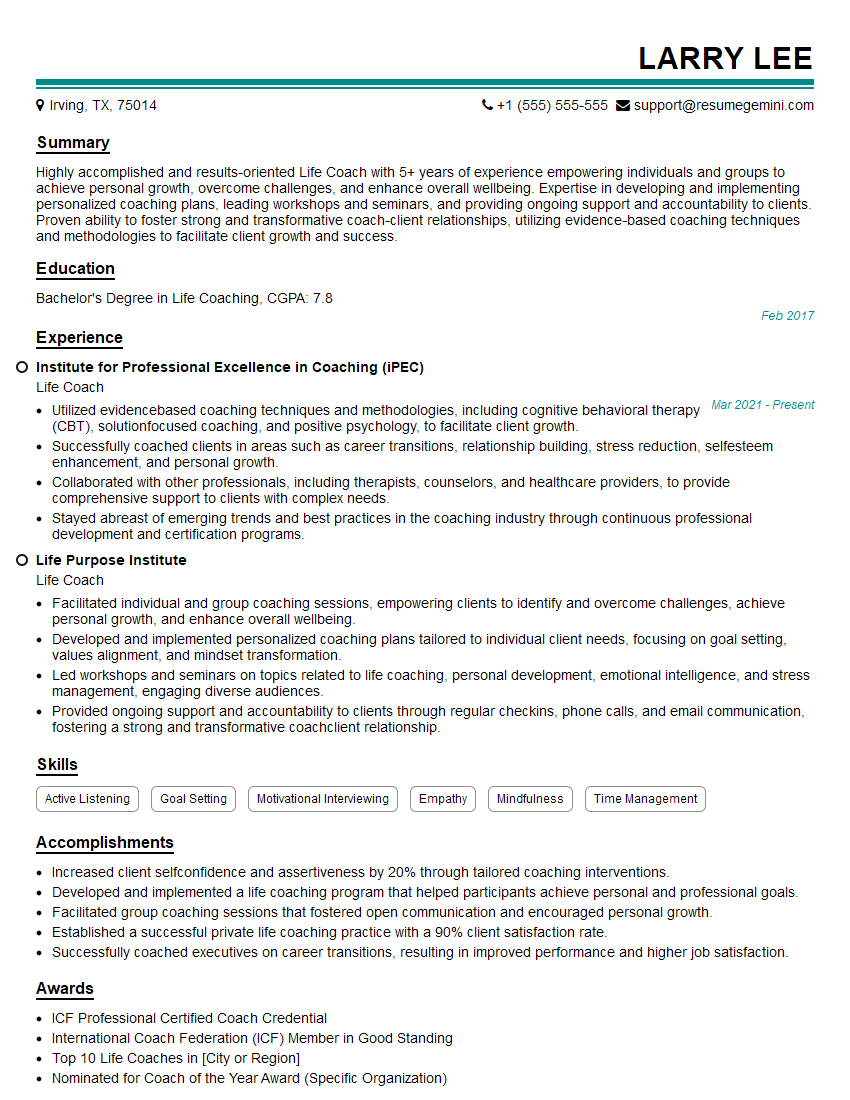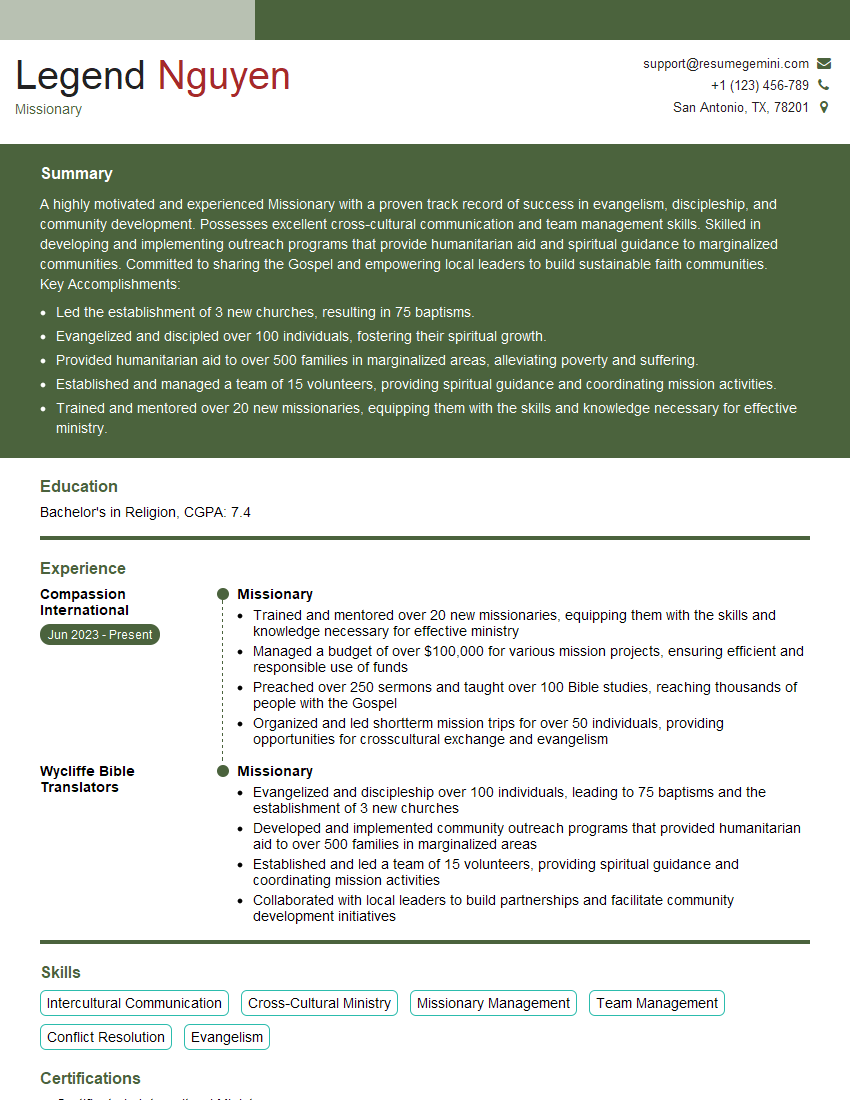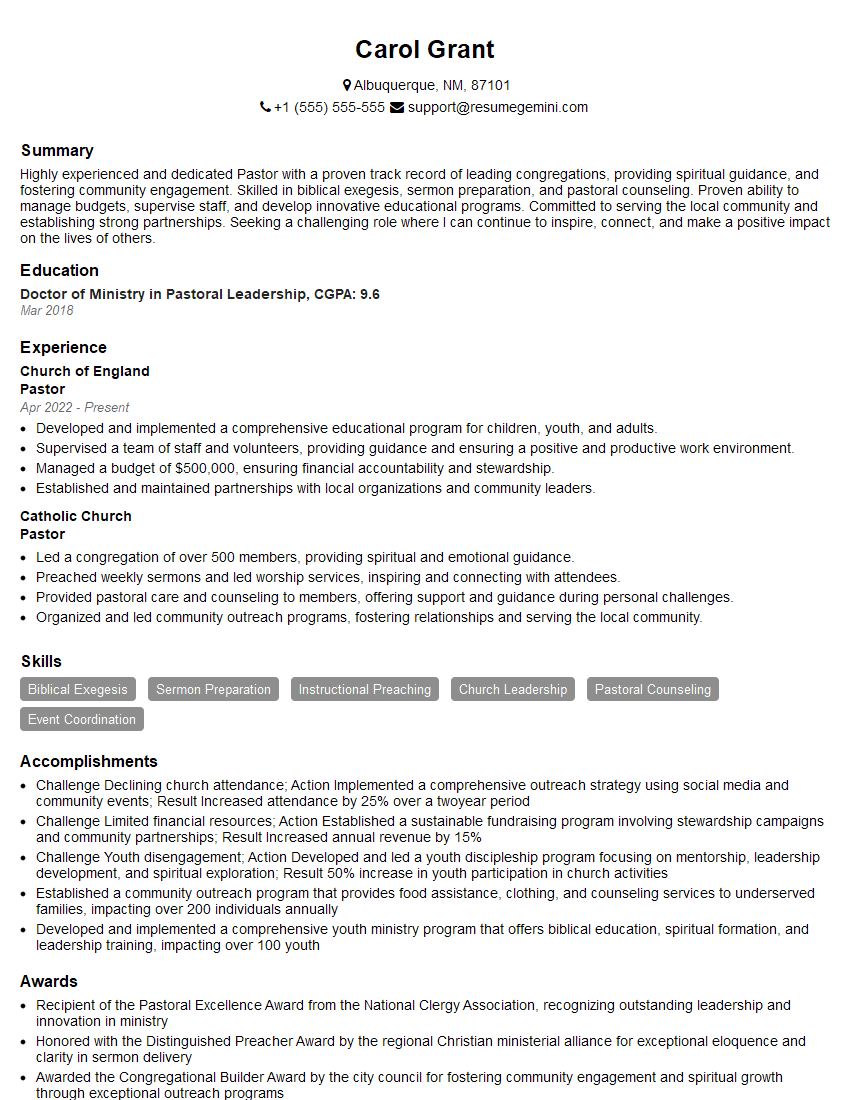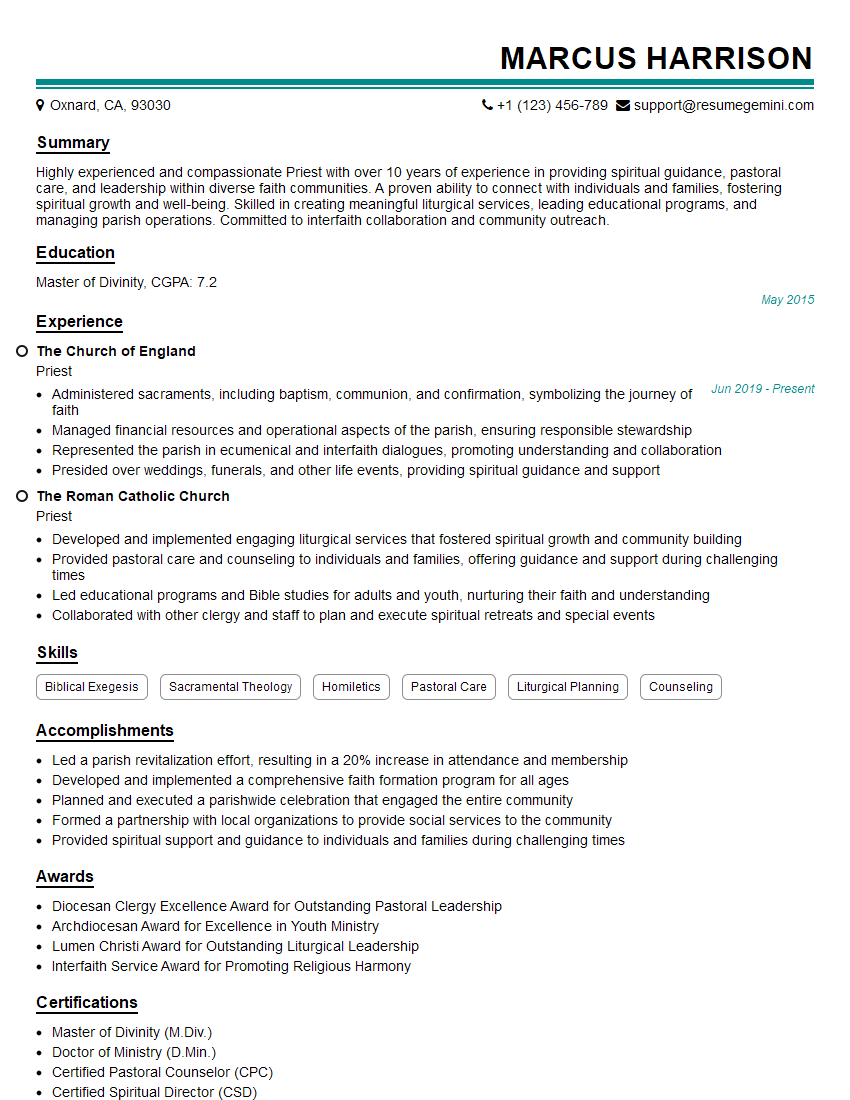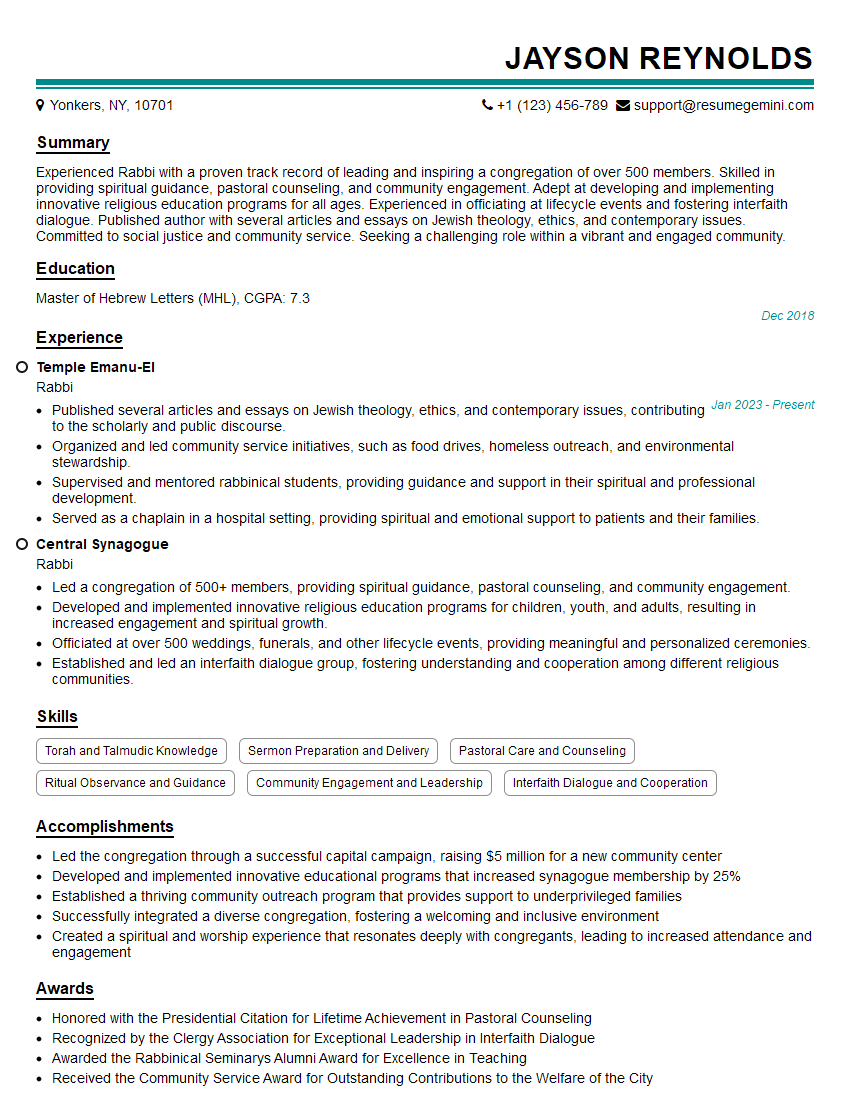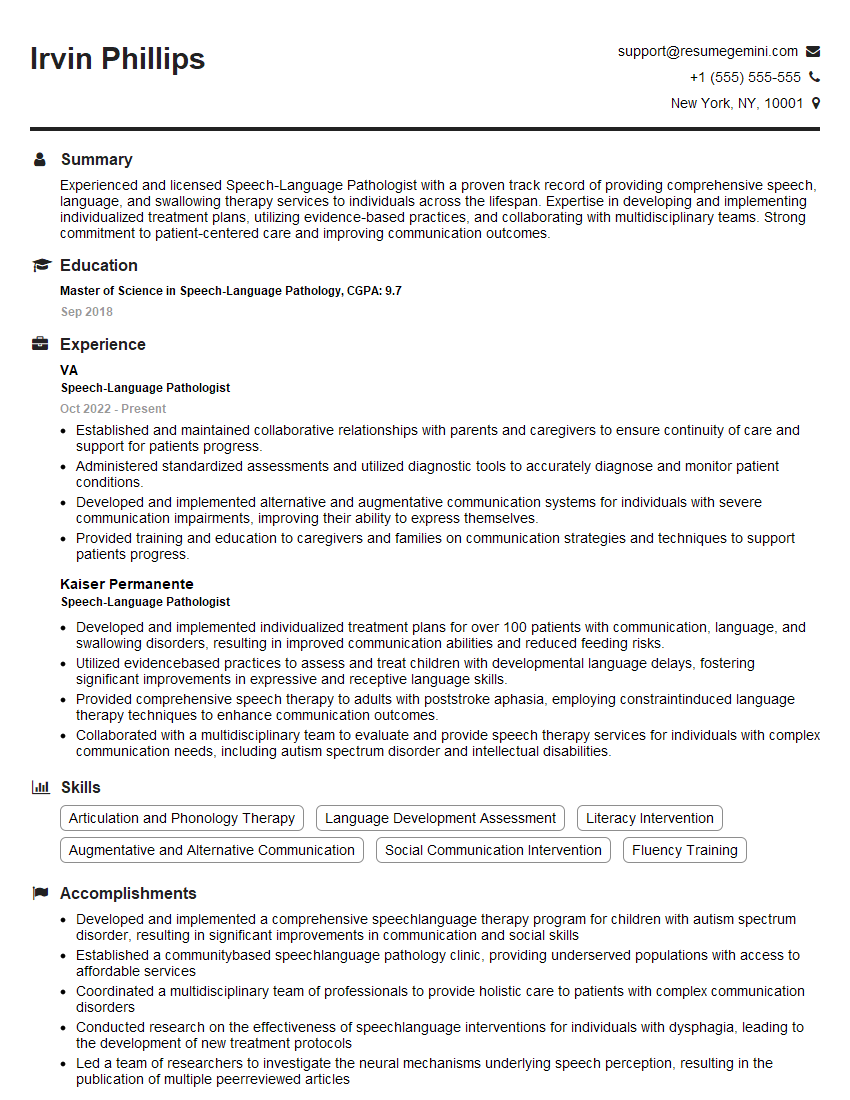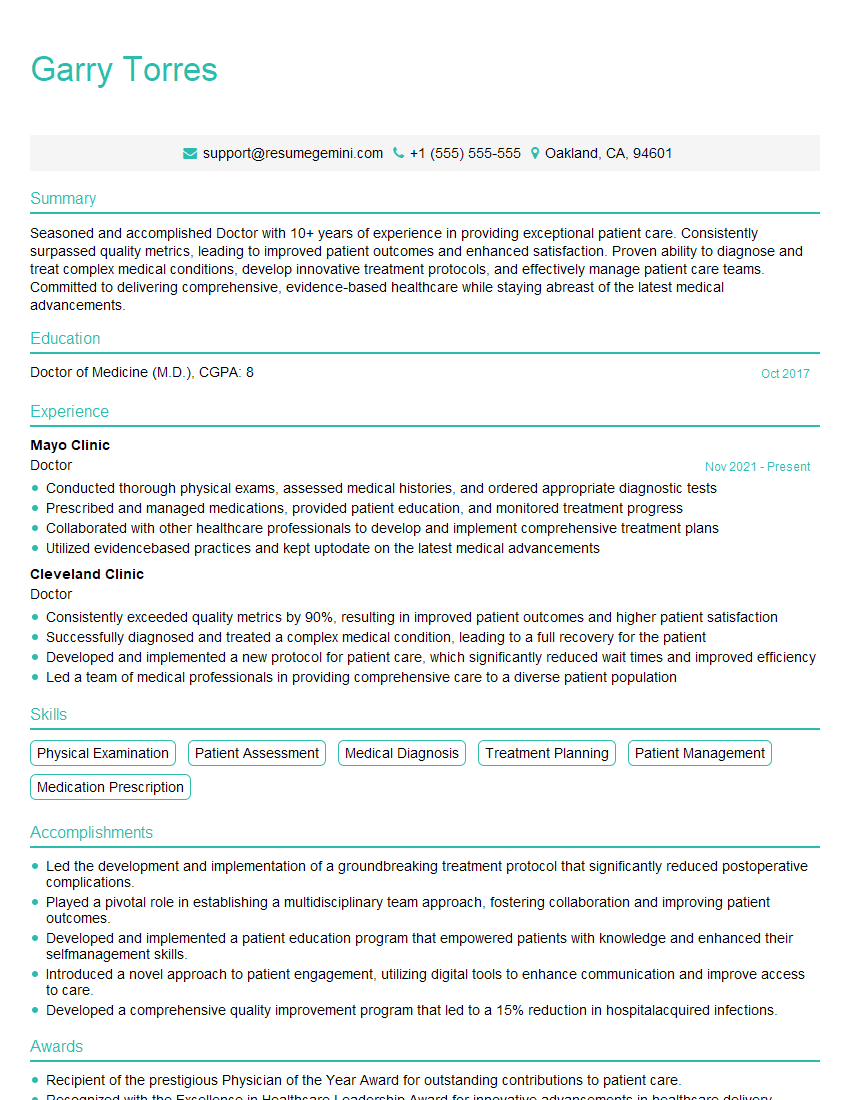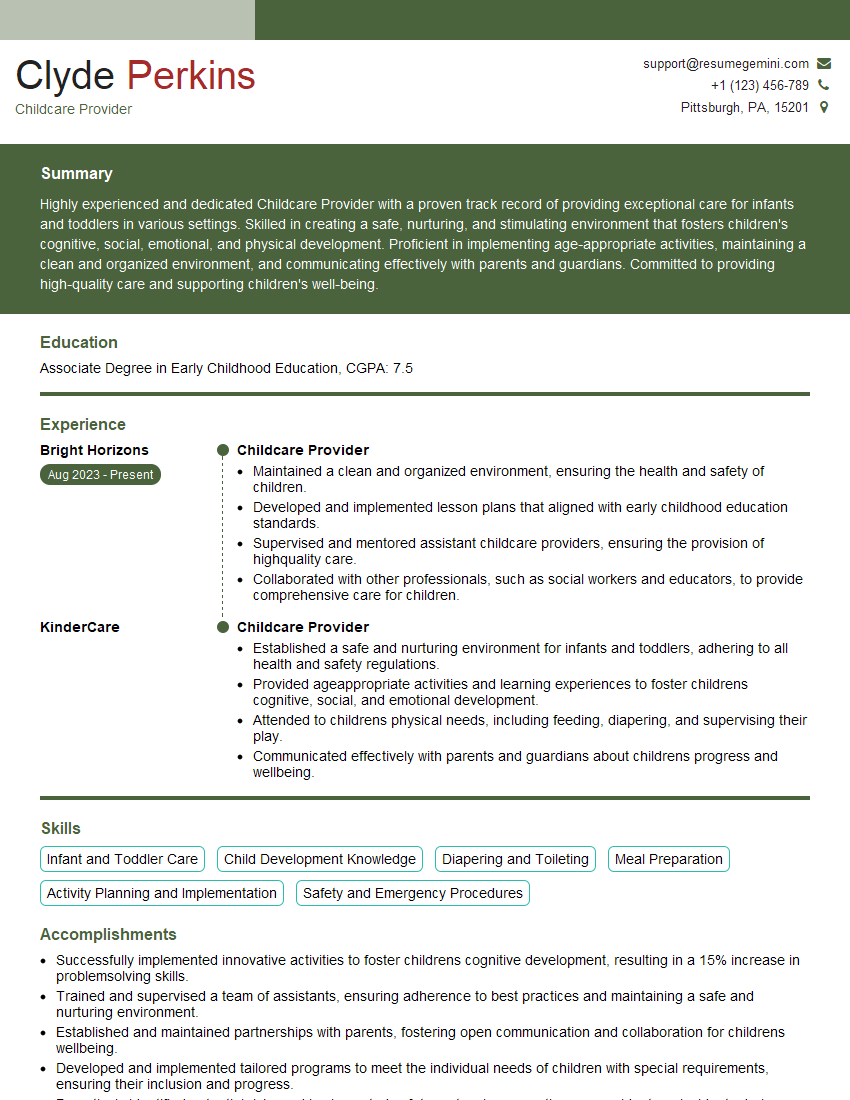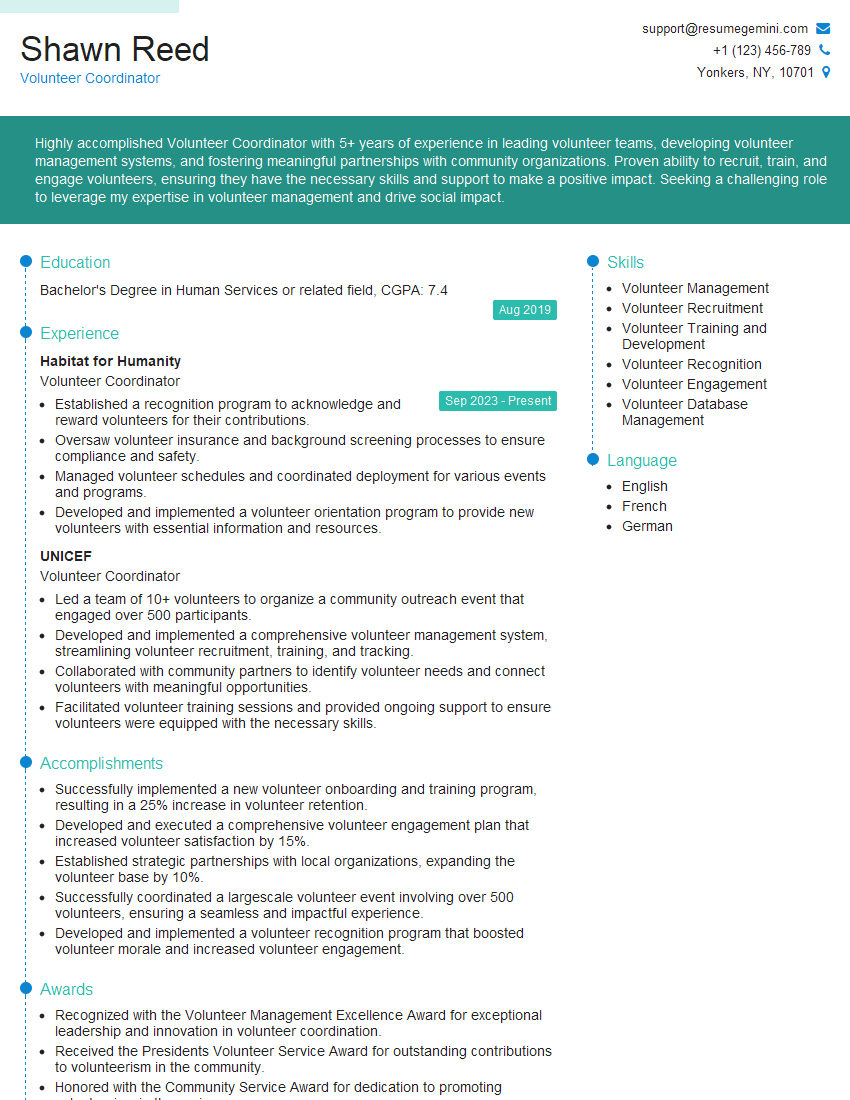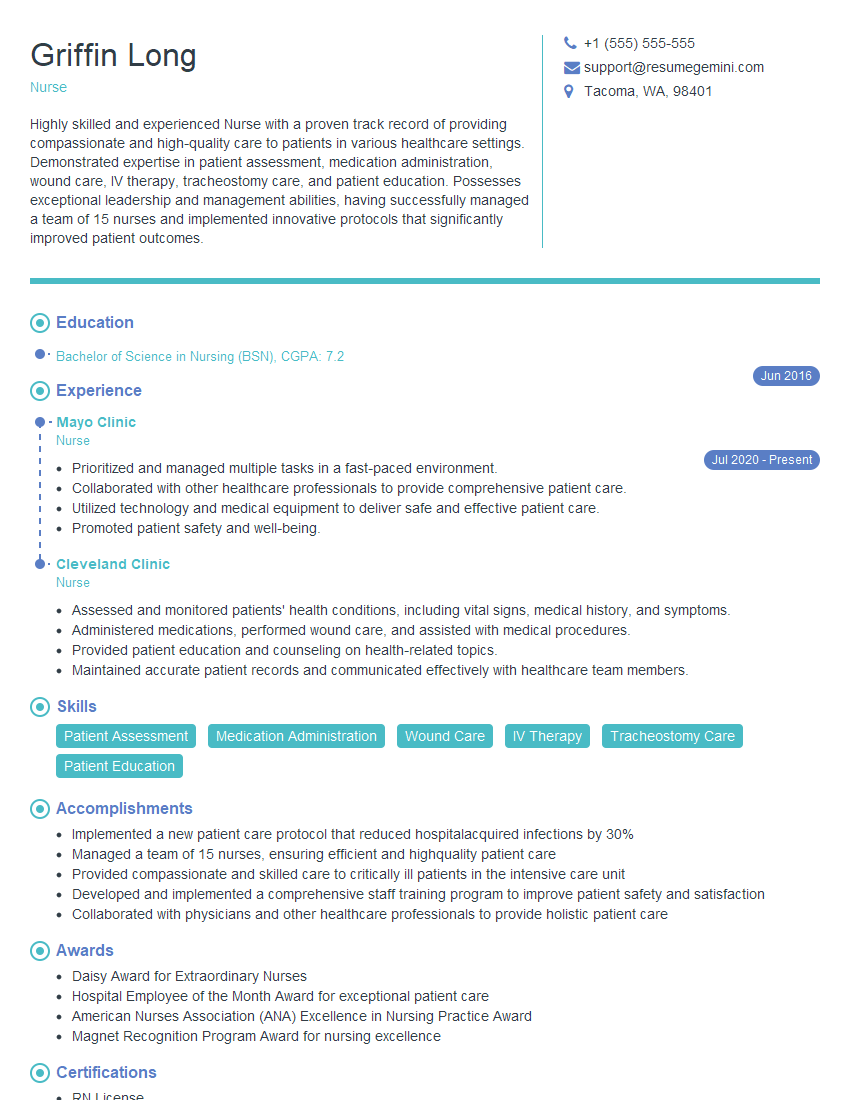Every successful interview starts with knowing what to expect. In this blog, we’ll take you through the top Passion for helping others and making a positive impact interview questions, breaking them down with expert tips to help you deliver impactful answers. Step into your next interview fully prepared and ready to succeed.
Questions Asked in Passion for helping others and making a positive impact Interview
Q 1. Describe a time you went above and beyond to assist someone.
Going above and beyond often involves anticipating needs and proactively offering support that extends beyond the expected. It’s about seeing the bigger picture and understanding the underlying challenges someone faces.
For instance, I once volunteered at a local homeless shelter. While my assigned task was serving meals, I noticed one individual, a veteran named John, struggling to navigate the resources available to him for finding housing and medical assistance. Simply serving him food wasn’t enough. I spent my break time helping him fill out applications, making calls on his behalf to veterans’ organizations, and even helping him organize his belongings. This extra effort resulted in John securing transitional housing and getting the medical care he desperately needed. It wasn’t just about the immediate action; it was about building trust and empowering him to navigate his own challenges.
Q 2. How do you measure the success of your efforts to help others?
Measuring the success of helping others isn’t always about quantifiable results. While tangible outcomes like securing housing or finding employment are valuable metrics, it’s equally important to assess the qualitative impact. I use a multi-faceted approach.
- Tangible Outcomes: Did the person achieve their goal? Did they secure housing, employment, or access to needed resources?
- Qualitative Changes: Did their confidence, self-sufficiency, or overall well-being improve? Did their situation stabilize? This often requires observation and open communication.
- Sustained Impact: Did the positive changes persist over time? Did they develop the skills and resources to maintain their progress independently?
Sometimes, even small steps forward are significant victories. The key is to understand that success is a journey, not just a destination, and to celebrate the progress made along the way.
Q 3. Explain a situation where you had to overcome resistance to help someone.
Overcoming resistance to help someone often requires empathy, patience, and skillful communication. You need to understand the underlying reasons for the resistance.
I once worked with a young woman who was fiercely independent and resisted accepting help with her financial struggles, believing it was a sign of weakness. Instead of pushing her, I listened empathetically to her concerns, validating her feelings without judgment. I reframed assistance as empowering, focusing on building skills rather than simply providing handouts. I offered her workshops on budgeting and financial literacy, empowering her to regain control of her finances. This collaborative approach, respecting her autonomy while offering support, ultimately led to her accepting help and making significant improvements in her financial situation.
Q 4. How do you prioritize competing needs when helping multiple individuals?
Prioritizing competing needs requires a systematic approach. It’s not about picking favorites; it’s about assessing urgency and long-term impact.
- Urgency Assessment: Identify immediate needs that require immediate attention. For example, someone facing eviction needs help more urgently than someone needing career advice.
- Long-Term Impact: Consider which actions will have the greatest lasting positive impact. Empowering someone with long-term skills is more valuable than providing temporary relief.
- Resource Allocation: Distribute available time and resources efficiently. Sometimes, this may involve seeking additional support or referring individuals to other organizations.
- Transparency and Communication: Openly communicate with all involved parties about priorities and the rationale behind decisions.
Think of it like triage in a hospital – those with the most critical needs are addressed first, while longer-term solutions are implemented for others.
Q 5. Describe your approach to resolving conflict between individuals you’re assisting.
Resolving conflict between individuals requires neutrality, active listening, and facilitation. My approach is based on fostering understanding and finding mutually acceptable solutions.
- Active Listening: Allow each person to express their perspective without interruption. Focus on understanding their feelings and needs.
- Neutral Facilitation: Avoid taking sides or imposing solutions. Guide the discussion towards identifying common ground and areas of compromise.
- Collaborative Problem-Solving: Help the individuals brainstorm solutions together, focusing on mutual benefit rather than assigning blame.
- Mediation: If the conflict escalates, it may be necessary to involve a neutral third party mediator.
The goal is not to force a resolution, but to empower the individuals to find a solution that works for everyone involved.
Q 6. How do you identify the root causes of problems you encounter while helping others?
Identifying root causes is crucial for long-term solutions. It’s about looking beyond surface-level issues to understand the underlying factors contributing to the problem.
- Open-Ended Questions: Ask open-ended questions to encourage individuals to share information and explore the context of their situation.
- Active Listening: Pay attention to both verbal and nonverbal cues to gain a deeper understanding.
- Systems Thinking: Consider the larger systems at play. Are there systemic issues contributing to the problem? For instance, lack of affordable housing, limited access to healthcare, or systemic bias?
- Data Collection: Gather relevant data to support your analysis. This might involve researching available resources or conducting informal assessments.
Think of it like diagnosing an illness: you need to identify the root cause, not just treat the symptoms, to achieve lasting improvement.
Q 7. How have you adapted your approach to helping others based on individual needs?
Adapting my approach based on individual needs is fundamental to effective help. Everyone is unique, and a one-size-fits-all approach is rarely successful.
For example, when assisting someone with job searching, I consider their skills, experience, and personality. An introverted person might benefit from targeted networking strategies, while an extroverted person might thrive in group workshops. Similarly, some individuals might need significant hands-on support, while others might benefit from more independent guidance. Understanding these individual differences and tailoring my support accordingly is key to achieving meaningful impact.
Q 8. Describe a time you failed to help someone effectively, and what you learned from it.
Early in my career, I volunteered at a homeless shelter and encountered a situation where I tried to impose a solution on a resident without fully understanding his needs. I suggested a job training program I thought would be ideal, but he lacked the necessary identification and stable housing, making the program inaccessible. My well-intentioned help was ultimately ineffective and even slightly frustrating for him.
This experience taught me the crucial importance of active listening and collaborative problem-solving. Instead of imposing my own ideas, I now prioritize understanding the individual’s perspective, identifying their specific challenges, and then collaboratively brainstorming solutions tailored to their unique circumstances. I learned that genuine help requires empathy, patience, and a willingness to adapt my approach based on the individual’s reality.
Q 9. How do you handle emotionally demanding situations while helping others?
Helping others can be emotionally draining, particularly when dealing with trauma or difficult life circumstances. My approach involves a combination of strategies:
- Self-awareness: I regularly check in with my own emotional state to identify signs of burnout or compassion fatigue. This involves recognizing my emotional limits and acknowledging when I need to step back.
- Setting Boundaries: It’s crucial to establish healthy boundaries to protect my own well-being. This includes limiting my involvement in certain cases if it’s overwhelming and seeking support from colleagues or supervisors when needed.
- Self-care: I prioritize activities that replenish my emotional reserves, such as exercise, spending time in nature, mindfulness practices, or engaging in hobbies.
- Seeking Support: I am part of a supportive professional network where we discuss challenging cases and share strategies for coping with emotional demands. This peer support is invaluable.
Think of it like a cup of water; you can’t pour from an empty cup. I need to take care of myself to effectively care for others.
Q 10. Describe your experience working collaboratively to achieve a positive impact.
In a previous role, I collaborated with a team of social workers and community organizers to implement a mentorship program for at-risk youth. We each contributed our unique skills and perspectives. I focused on curriculum development and program logistics, while others handled community outreach and fundraising.
Our success stemmed from clear communication, shared goals, and a commitment to mutual support. We regularly met to discuss progress, address challenges, and adjust our strategies as needed. The program significantly improved the youth’s academic performance and social-emotional well-being, demonstrating the power of collaborative effort in achieving a positive impact. This experience reinforced my belief that effective collaboration requires trust, open communication, and a shared vision.
Q 11. How do you stay motivated when faced with challenging situations related to helping others?
Maintaining motivation in challenging situations within a helping profession requires a combination of intrinsic and extrinsic factors.
- Focus on impact: I constantly remind myself of the positive change I’m making in the lives of others. Seeing even small improvements in someone’s well-being serves as a powerful motivator.
- Celebrate successes: It’s important to acknowledge and celebrate achievements, both large and small. This helps maintain momentum and build resilience.
- Seek inspiration: I regularly connect with colleagues, mentors, and inspiring stories from within the field to recharge my passion and commitment.
- Continuous learning: Staying updated on best practices and new developments within my field keeps me engaged and motivated to refine my skills and approaches.
It’s like climbing a mountain; there will be difficult parts, but the view from the top is worth the effort.
Q 12. How do you build trust and rapport with individuals you are helping?
Building trust and rapport is fundamental to effective help. It’s a process that requires time, patience, and genuine empathy.
- Active listening: I pay close attention to what individuals are saying, both verbally and nonverbally. I strive to understand their perspectives and feelings, without judgment.
- Empathy and validation: I try to see the world through their eyes and validate their emotions. Showing genuine understanding fosters trust.
- Respect and confidentiality: I treat each individual with respect and maintain strict confidentiality. This is essential for creating a safe space where they can feel comfortable sharing their experiences.
- Consistent reliability: I follow through on my commitments and consistently demonstrate trustworthiness. This builds confidence and encourages continued engagement.
Building rapport is like planting a seed; it requires nurturing and patience before it grows into a strong relationship.
Q 13. Explain how your values align with helping others and making a positive impact.
My core values of compassion, empathy, justice, and integrity directly align with my passion for helping others and making a positive impact.
- Compassion drives me to understand and alleviate suffering.
- Empathy allows me to connect with individuals on a deeper level and understand their unique needs.
- Justice motivates me to advocate for fairness and equity for all.
- Integrity guides my actions and ensures that I act ethically and responsibly in all my interactions.
These values form the foundation of my approach and guide my decisions in every aspect of my work.
Q 14. How do you manage your own well-being while working in a helping profession?
Working in a helping profession can be incredibly rewarding but also emotionally and physically demanding. Maintaining my own well-being is non-negotiable.
- Regular self-reflection: I regularly evaluate my emotional and physical state and identify areas needing attention.
- Setting boundaries: I consciously set boundaries to prevent burnout by prioritizing self-care and avoiding overcommitment.
- Seeking support: I actively seek support from colleagues, supervisors, mentors, or therapists when facing challenging situations.
- Prioritizing self-care: I engage in activities that promote physical and mental well-being, such as exercise, mindfulness, spending time in nature, and pursuing hobbies.
- Professional development: I participate in continuing education opportunities to stay updated on best practices and refine my skills. This also keeps me motivated and prevents stagnation.
Taking care of myself is not selfish; it’s essential to my ability to effectively help others.
Q 15. How do you measure the long-term impact of your efforts to help others?
Measuring the long-term impact of helping others requires a multifaceted approach, moving beyond immediate gratification to assess sustained positive change. It’s not just about counting beneficiaries, but understanding the depth and durability of the effects.
Quantitative Data: Tracking metrics like improved health outcomes (reduced hospital readmissions, increased life expectancy), enhanced educational attainment (graduation rates, test scores), or economic empowerment (increased income, job creation) provides concrete evidence of success. For instance, if I’m mentoring underprivileged youth, I’d track their academic progress, college acceptance rates, and eventual career paths.
Qualitative Data: Gathering testimonials, conducting interviews, and observing behavioral changes paints a richer picture. This might involve gathering feedback from participants about their increased self-esteem, confidence, or sense of community. For a community development project, observing sustained participation in community events or reduced crime rates would offer qualitative evidence.
Sustainability: Assessing the long-term viability of the initiative is crucial. Does the program have a sustainable funding model? Are there mechanisms for ongoing support and capacity building so that the positive impact continues even after initial involvement ends? For example, establishing local leadership and providing ongoing training ensures project longevity.
Impact Assessment Studies: For larger-scale projects, conducting formal impact assessments, utilizing control groups, and employing statistical analysis can rigorously measure the program’s effects over time. This would involve a structured evaluation process, comparing the outcomes of participants to a control group that didn’t receive the intervention.
Career Expert Tips:
- Ace those interviews! Prepare effectively by reviewing the Top 50 Most Common Interview Questions on ResumeGemini.
- Navigate your job search with confidence! Explore a wide range of Career Tips on ResumeGemini. Learn about common challenges and recommendations to overcome them.
- Craft the perfect resume! Master the Art of Resume Writing with ResumeGemini’s guide. Showcase your unique qualifications and achievements effectively.
- Don’t miss out on holiday savings! Build your dream resume with ResumeGemini’s ATS optimized templates.
Q 16. Describe a time you had to advocate for someone in need.
I once advocated for a young woman facing unfair dismissal from her job due to a disability. She was highly skilled and dedicated, but her employer, unaware of the intricacies of managing employees with disabilities, was overlooking her capabilities. I worked with her to gather documentation of her work performance, highlighting her accomplishments and contributions. Then, I contacted the employer’s HR department, explained the legal implications of discriminatory practices, and offered practical solutions for accommodating her needs. The process involved several meetings and considerable negotiation but ultimately resulted in her reinstatement, with appropriate accommodations put in place. This experience highlighted the importance of understanding employment law, effectively communicating complex information, and the power of persistent advocacy.
Q 17. How do you balance your desire to help with the need for realistic expectations?
Balancing the desire to help with realistic expectations is crucial to avoid burnout and maintain the integrity of my work. It requires a combination of empathy, strategic planning, and self-awareness.
Setting Achievable Goals: Instead of aiming for unrealistic, sweeping changes, I break down large problems into smaller, manageable steps. This allows for regular progress assessments and prevents feeling overwhelmed.
Prioritization: Focusing on the most pressing needs first, while acknowledging that not every problem can be solved immediately, allows for impactful action without spreading resources too thin.
Collaboration: Recognizing limitations and seeking support from other professionals or organizations expands capacity and ensures sustainability. No one person can solve every problem alone.
Self-Care: Prioritizing my own well-being prevents compassion fatigue. Regular breaks, reflection, and seeking support from peers are essential to maintain long-term effectiveness.
Q 18. How do you stay updated on best practices in your field related to helping others?
Staying updated involves a proactive approach to continuous learning. I utilize a variety of resources to ensure I’m applying the most effective and ethical strategies.
Professional Networks: Participating in relevant professional organizations, attending conferences, and engaging in online forums provides opportunities to learn from peers and experts.
Academic Research: Staying current on research findings in relevant fields, such as social work, psychology, and public health, informs my understanding of best practices.
Continuing Education: Pursuing advanced certifications and workshops expands my skillset and keeps my knowledge up-to-date.
Case Studies and Publications: Reviewing case studies and reading professional journals provides valuable insights into successful and unsuccessful interventions.
Q 19. How do you handle criticism or feedback related to your work in helping others?
Criticism and feedback are essential components of growth and improvement. I view them as opportunities to learn and refine my approaches.
Active Listening: Approaching feedback with an open mind and listening attentively to the concerns raised. I ask clarifying questions to fully understand the perspective of the person providing the feedback.
Self-Reflection: Carefully considering the validity of the feedback and identifying areas for improvement. This involves honest self-assessment and a willingness to acknowledge areas for growth.
Actionable Steps: Developing a plan to implement changes based on the received feedback. This may involve modifying strategies, seeking additional training, or improving communication.
Constructive Dialogue: Engaging in a thoughtful discussion with the person providing feedback, clarifying misunderstandings and showing a commitment to improvement.
Q 20. Describe a time you had to make a difficult decision that impacted someone else.
In a community development project, I had to make the difficult decision to reallocate resources away from a less effective program to one demonstrating significantly greater impact. While the less effective program had some positive aspects, data clearly showed that its impact was minimal compared to the other program. It was painful to inform the participants and the program leaders of the decision, but I carefully explained the data-driven rationale and offered alternative resources and support. The decision was not easy, but prioritizing effectiveness and maximizing the positive impact on a larger population was the ethically responsible course of action. Transparency and communication were key to navigating this challenging situation.
Q 21. How do you ensure confidentiality and ethical considerations when helping others?
Confidentiality and ethical considerations are paramount in my work. I adhere to strict guidelines to protect the privacy and well-being of those I assist.
Informed Consent: Always obtaining informed consent before collecting or sharing any personal information. This includes clearly explaining the purpose of data collection, how it will be used, and who will have access.
Data Security: Employing secure storage and handling procedures for sensitive information, adhering to relevant privacy laws and regulations.
Professional Boundaries: Maintaining professional boundaries to prevent conflicts of interest and prioritize the client’s best interests.
Reporting Requirements: Adhering to mandatory reporting requirements for situations involving abuse, neglect, or other legally mandated disclosures. Understanding these requirements is crucial for ethical practice.
Ethical Review Boards: For research or program evaluations, securing approval from relevant ethical review boards to ensure all activities are conducted ethically and legally.
Q 22. How do you handle situations where you cannot provide the help someone needs?
It’s crucial to remember that I can’t solve every problem. When faced with a situation where I can’t directly provide the help someone needs, my first step is a thorough needs assessment. This involves actively listening, asking clarifying questions, and understanding the individual’s specific circumstances and limitations.
Then, I focus on connecting them to the appropriate resources. This could involve referring them to specialists, community organizations, or other support systems better equipped to address their specific needs. For example, if someone is struggling with severe mental health issues, I wouldn’t attempt to treat them myself; instead, I’d refer them to a qualified therapist or psychiatrist.
Finally, I ensure there’s a smooth transition, following up to check on their progress and offer continued support where appropriate. This process of acknowledging limitations while actively seeking solutions is crucial for ethical and effective helping practice.
Q 23. Describe your experience with different approaches to helping individuals.
My approach to helping individuals is multifaceted and depends heavily on the specific context and the individual’s needs. I’ve utilized various methods, including:
- Direct Support: Providing direct assistance, like helping someone complete a task or navigate a system. For example, I assisted a senior citizen with completing their tax return.
- Advocacy: Speaking up for someone’s rights and needs when they can’t do so themselves. For instance, I advocated for a patient whose insurance was denying essential medical treatment.
- Mentorship: Guiding and supporting individuals toward self-sufficiency and growth. I’ve mentored several young adults helping them plan their career paths.
- Community Building: Facilitating collaboration and creating a supportive environment where individuals can help each other. This has involved organizing volunteer events and fostering strong community connections.
The key is flexibility and adaptability; I choose the most effective approach based on the individual’s situation and my abilities.
Q 24. How do you assess the needs of an individual or community before providing assistance?
Assessing individual and community needs is a systematic process. It begins with active listening and observation. I aim to understand the situation from the individual’s perspective, appreciating their unique background, experiences, and values. This involves asking open-ended questions and actively listening to their responses without judgment.
For community assessments, I use a range of methods including surveys, focus groups, and analyzing existing data to get a holistic picture. I use a combination of quantitative (e.g., statistical data on poverty rates) and qualitative data (e.g., interviews with community members to understand their lived experiences).
The ultimate goal is to understand the root causes of the issue, not just the symptoms. For instance, if homelessness is an issue, instead of just focusing on providing shelter, a thorough assessment might reveal underlying issues like mental health challenges or joblessness which require a more comprehensive intervention strategy.
Q 25. Describe a time you had to adapt your communication style to effectively help someone.
I once worked with a young man who was struggling with severe grief and was very withdrawn. My initial attempts at direct conversation were unsuccessful. He seemed overwhelmed and avoided eye contact. I realized I needed to adapt my communication style.
Instead of direct questioning, I chose to spend time with him in silence, offering my presence and support without pressure. Gradually, through shared activities like gardening, he started to open up. My approach shifted from verbal communication to nonverbal support and shared experiences, demonstrating empathy and understanding. This adaptation was key to establishing trust and enabling him to process his grief.
Q 26. How do you determine when to seek assistance from other professionals or resources?
Recognizing my limitations is a vital aspect of my approach. I seek assistance from other professionals or resources when the situation is beyond my expertise, resources, or scope of practice. This is not a sign of weakness but a demonstration of responsible practice.
Factors that trigger seeking outside help include:
- Complexity of the issue: If the problem requires specialized knowledge (e.g., legal, medical, psychological).
- Safety concerns: If there is a risk of harm to the individual or others.
- Resource limitations: If I lack the necessary time, skills, or resources to provide effective assistance.
- Ethical considerations: If a conflict of interest arises or my personal biases could impede objective support.
I prioritize the well-being of the individual and understand that collaborating with others is often the most effective way to provide comprehensive support.
Q 27. Describe a time you demonstrated resilience while working in a helping profession.
During my work with a marginalized community, we faced repeated setbacks in securing funding for a vital community center. There were countless bureaucratic hurdles, and several times, we were close to giving up. However, the residents’ unwavering hope and determination inspired me.
We adapted our funding strategy, explored alternative avenues, and engaged in community organizing to raise awareness and amplify the need. After many months of persistent effort and collaboration, we finally secured the funding, demonstrating resilience and commitment amidst significant challenges. This experience reinforced the importance of collaboration, perseverance, and faith in the face of adversity.
Q 28. How do you maintain a positive outlook when working with challenging individuals or situations?
Maintaining a positive outlook in challenging situations is essential for both my well-being and my ability to effectively support others. I actively practice several strategies:
- Self-care: Prioritizing my physical and mental health through exercise, mindfulness, and time for personal pursuits prevents burnout and allows me to approach challenges with renewed energy.
- Focusing on successes: Regularly reflecting on past successes, even small ones, helps to counteract the impact of difficult experiences and maintain hope.
- Connecting with others: Sharing experiences and seeking support from colleagues and mentors provides perspective and helps to alleviate feelings of isolation.
- Finding meaning: Remembering my core values and the purpose behind my work motivates me even in challenging moments. Helping others provides intrinsic reward which sustains a positive outlook.
Ultimately, a positive outlook is not about ignoring difficulties, but about maintaining hope and resilience in the face of challenges. This enables me to maintain empathy, offer effective support, and make a positive impact.
Key Topics to Learn for Passion for Helping Others and Making a Positive Impact Interview
- Defining Your “Why”: Articulate your genuine passion for helping others and the positive impact you seek to create. Explore your motivations and values driving this passion.
- Demonstrating Impact: Learn to effectively showcase instances where you’ve positively influenced individuals or communities. Prepare specific examples illustrating your contributions and the resulting outcomes.
- Problem-Solving with Empathy: Practice analyzing situations requiring assistance, identifying needs, and developing solutions that consider the perspectives and feelings of those involved.
- Teamwork and Collaboration: Highlight your ability to work effectively with others to achieve common goals focused on service and positive impact. Share experiences emphasizing collaborative problem-solving and shared successes.
- Adaptability and Resilience: Discuss your approach to handling challenges and setbacks while maintaining your commitment to helping others. Showcase your ability to adapt strategies and remain persistent in the face of adversity.
- Ethical Considerations: Reflect on ethical dilemmas you’ve encountered in helping others and how you navigated them. Discuss your commitment to integrity and responsible action.
- Long-Term Vision: Articulate your aspirations for making a lasting positive impact. Demonstrate your forward-thinking approach and commitment to sustained contributions.
Next Steps
Mastering the ability to effectively communicate your passion for helping others and making a positive impact is crucial for career advancement across numerous fields. It demonstrates character, commitment, and a proactive approach to problem-solving—qualities highly valued by employers. To significantly enhance your job prospects, focus on crafting an ATS-friendly resume that showcases these attributes. ResumeGemini is a trusted resource that can help you build a professional resume tailored to highlight your unique skills and experiences. Examples of resumes specifically designed for candidates emphasizing a passion for helping others and making a positive impact are available to guide you.
Explore more articles
Users Rating of Our Blogs
Share Your Experience
We value your feedback! Please rate our content and share your thoughts (optional).
What Readers Say About Our Blog
Hi, I have something for you and recorded a quick Loom video to show the kind of value I can bring to you.
Even if we don’t work together, I’m confident you’ll take away something valuable and learn a few new ideas.
Here’s the link: https://bit.ly/loom-video-daniel
Would love your thoughts after watching!
– Daniel
This was kind of a unique content I found around the specialized skills. Very helpful questions and good detailed answers.
Very Helpful blog, thank you Interviewgemini team.
